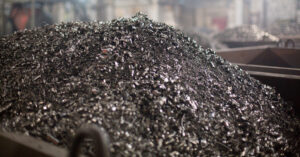
In January-May 2025, imports of tin and tin products to Ukraine increased by 70.5% to $1.739 million. In May, products worth $568 thousand were imported.
At the same time, tin exports decreased by 41.1% to $86 thousand compared to $146 thousand last year. In May, exports amounted to $30 thousand.
For the whole of 2024, tin imports increased by 16.9% to $3.188 million, while exports increased by 2.5 times to $389 thousand. In 2023, imports amounted to $2.728 million, while exports amounted to $159 thousand.

In January-May 2025, Ukraine imported zinc and zinc products worth $21.319 million, down 8.1% compared to the same period in 2024. In May, imports amounted to $6.237 million.
Exports of zinc products increased to $523 thousand against $84 thousand in the first five months of 2024. In May 2025, $113 thousand were exported.
In 2024, zinc imports reached $58.610 million (+27.5% compared to 2023), while exports amounted to $563 thousand. In 2023, imports were $45.966 million and exports were $130 thousand.

In January-May this year, Ukraine increased exports of processed pig iron in physical terms by 45.2% compared to the same period last year, up to 736,418 thousand tons from 507,106 thousand tons.
According to statistics released by the State Customs Service (SCS) on Friday, pig iron exports in monetary terms increased by 53.2% to $290.546 million during the period under review.
At the same time, exports were carried out mainly to the United States (79.11% of supplies in monetary terms), Italy (10.23%) and Turkey (5.90%).
In the first 5 months of the year, the country imported 29 thousand tons worth $55 thousand from Brazil (68.52%) and Germany (31.48%), while in January-May 2024, 15 tons of pig iron were imported for $35 thousand.
As reported, on March 12 this year, the United States began levying a 25% duty on imports of Ukrainian steel products, except for pig iron, in accordance with President Donald Trump’s decision.
In 2024, Ukraine reduced exports of processed pig iron by 3.4% in physical terms compared to 2023, to 1 million 290.622 thousand tons, and by 6.1% in monetary terms, to $500.341 million. Exports were mainly to the United States (72.64% of supplies in monetary terms), Turkey (8.03%) and Italy (7.30%).
In 2024, the country imported 38 tons of pig iron worth $90 thousand from Germany, while in the same period of 2023 it imported 154 tons of pig iron worth $156 thousand.

In January-May 2025, Ukraine imported medicines in dosage forms or packaged for retail trade for a total of $836.281 million.
According to the State Customs Service, exports of medicines during this period amounted to $92.989 million in monetary terms.
In addition, in the first five months of 2025, Ukraine imported non-dosed and non-packaged medicines for retail trade for $4.99 million, and ketgut, reagents, contrast agents, contraceptives and dental materials for $27 million.
The main countries from which Ukraine imports medicines are Germany (19.7%), India (10.4%) and France (7.36%). The main export markets are Uzbekistan (19.94%), Lithuania (19.7%) and Kazakhstan (13.4%).

In January-May this year, Ukraine increased its exports of ferroalloys in physical terms by 6.7 times compared to the same period last year – up to 45,002 thousand tons from 6,670 thousand tons.
According to statistics released by the State Customs Service (SCS) on Friday, exports of ferroalloys increased 5.2 times in monetary terms to $49.902 million.
The main exports were to Poland (32.69% of supplies in monetary terms), Turkey (21.88%) and Algeria (20.81%).
In addition, in 5 months of 2025, Ukraine imported 17.222 thousand tons of these products, a 64.3% decrease compared to the first 5 months of 2024. In monetary terms, imports fell by 55.7% to $34.684 million. Imports were carried out mainly from Norway (25.71%), Kazakhstan (16.73%) and Georgia (9.84%).
As reported, Pokrovsky Mining and Processing Plant (PGOK, formerly Ordzhonikidze Mining and Processing Plant) and Marganetsky Mining and Processing Plant (MGOK, both in Dnipropetrovska oblast), both part of Privat Group, stopped mining and processing of crude manganese ore in late October and early November 2023, while NFP and ZFP stopped smelting ferroalloys. In the summer of 2024, ferroalloy plants resumed production at a minimal level.
In 2024, Ukraine reduced exports of ferroalloys in physical terms by 4.45 times compared to 2023 – to 77.316 thousand tons from 344.173 thousand tons, while in monetary terms, exports decreased by 3.4 times – to $88.631 million from $297.595 million. The main exports were to Poland (27.40% of supplies in monetary terms), Turkey (21.53%) and Italy (19.82%).
In addition, last year Ukraine imported 82.259 thousand tons of these products compared to 14.203 thousand tons in 2023 (an increase of 5.8 times). In monetary terms, imports increased by 3.3 times to $140.752 million from $42.927 million. Imports were carried out mainly from Poland (32.71%), Norway (19.55%) and Kazakhstan (13.90%).
Prior to the nationalization of the financial institution, PrivatBank organized the business of ZZF, NZF, Stakhanovsky ZF (which is on the NKT), Pokrovske and Marganetske GOKs. Nikopol Ferroalloy Plant is controlled by EastOne Group, created in the fall of 2007 as a result of the restructuring of Interpipe Group, and Privat Group.